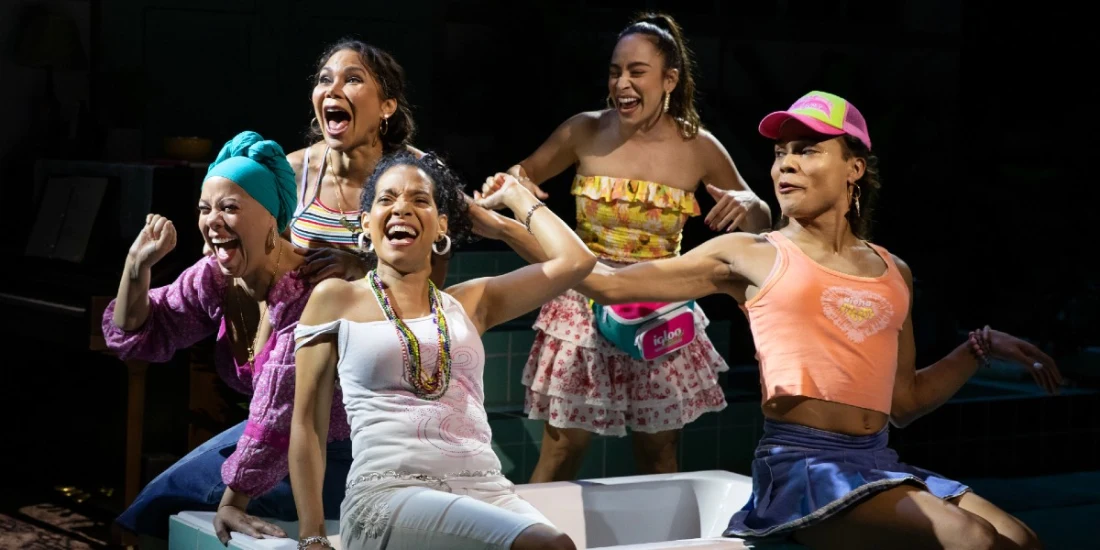'My Broken Language' review — English, Spanish, and dance tell a vibrant family story
On paper, My Broken Language at Signature Theatre is a stage adaptation of Quiara Alegría Hudes's (In the Heights, Water by the Spoonful) same-named memoir, about finding the right blend of languages to capture the full vitality of her vibrant Puerto Rican family. On stage, the show is a living museum to the Pulitzer-winning playwright's family, constantly in motion, as the perfect cocktail of expression includes more than words. Visuals and movement are just as necessary to honor her family as English and Spanish are.
In other words, there's no better way to present Hudes's family story than as a play, which she also directed. That's evident from the opening moment, in which a frustrated woman clacks away at her laptop, stops, hits delete, and gets up to dance. Suddenly, My Broken Language bursts alive as four more actors and a piano player flood the teal-tiled stage (Arnulfo Maldonado did the gorgeous set) with more joyous dancing and music.
They say the play's title and set the scene: "My Broken Language. North Philly. 1988." We realize we're watching what Hudes was writing at that laptop. Except now, it's transcended mere writing. Hudes has brought the story alive, and in some cases, resurrected its characters in flesh and blood.
Save for the pianist (Ariacne Trujillo-Durand), every actor plays Hudes — "Qui Qui," she's affectionately called — at least once. They pass around a necklace, Sisterhood of the Traveling Pants-style, to signal who's in the role at any given moment. And like the pants of that film series, Hudes's persona fits every actor like it was bespoke.
Yet, Zabryna Guevara, Yani Marin, Samora la Perdida, Daphne Rubin-Vega, and Marilyn Torres also each bring a unique flair to Hudes and a variety of other family members, with none feeling out of place. Rather, together, they're a physical representation of how all these people shaped Hudes.
Rubin-Vega is up first as a 10-year-old Hudes, exuding childlike energy even as she speaks Hudes's sophisticated words. La Perdida brings vulnerability to a 13-year-old Hudes as she watches her mother channel a spirit in a sacred ritual, and Guevara is punchy without being harsh as the hardened, grief-stricken 15-year-old Hudes. By the time we get to Torres as the 18-year-old Hudes, she feels motherly and mature, as she tenderly dyes her cousin's hair and honors her by diving into literature.
Finally is Marin, who superbly dances (not speaks) the part of Hudes in a ballet inspired by Hudes's grandmother's rice recipe. She also dances the part of the possessed mother, with nearly scary ferocity as she seems to fight against her own moving body, in the 13-year-old Hudes scene. These scenes, and an ending one where Guevara dances as Hudes in a writing frenzy, exemplify My Broken Language's message to perfection. What English cannot express, Spanish sometimes can, but what words in any spoken language cannot, the language of the body can. Ebony William's explosive choreography is as clear a storytelling tool as Hudes's words.
Every language on its own is broken, insufficient. But together, in My Broken Language, they make a complete, sublime whole that celebrates a family's life and legacy.
UPDATE: A previous version of this review misidentified the ritual Hudes's mother underwent. The review has been updated.
Photo credit: Marilyn Torres, Daphne Rubin-Vega, Zabryna Guevara, Yani Marin, and Samora la Perdida in My Broken Language. (Photo by Julieta Cervantes)
Originally published on
